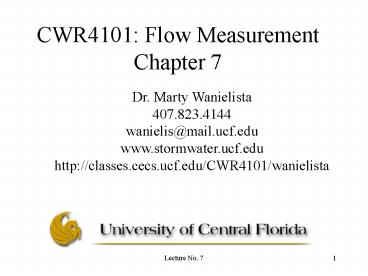CWR4101: Flow Measurement Chapter 7 - PowerPoint PPT Presentation
1 / 28
Title:
CWR4101: Flow Measurement Chapter 7
Description:
Table 7.2 Depth Measurement Points for Velocity and Averaging Equation. Lecture No. 7 ... Selection table as a function of range of measurements ... – PowerPoint PPT presentation
Number of Views:147
Avg rating:3.0/5.0
Title: CWR4101: Flow Measurement Chapter 7
1
CWR4101 Flow Measurement Chapter 7
Dr. Marty Wanielista 407.823.4144 wanielis_at_mail.uc
f.edu www.stormwater.ucf.edu http//classes.cecs.u
cf.edu/CWR4101/wanielista
2
Applications
- Streamflow velocities and flow rates
- Control devices for hydrograph peak attenuation
- Runoff measurement
- Low flow controls
3
Circular Weir with Baffle
4
Pond Discharge Control
5
Streamflow Measurement Devices
- Direct Measurement (volumes over time)
- Indirect Measurements
- Stage or depth for velocity area or Manning
- Weir or orifice
- Pressure converted to depth
- Dilution via mass balance
- Flumes
6
Streamflow
- 1. Velocity Area Method
Flow gage at one or more depths
7
Staff Gage, Stage and Depth
Depth Gage
Water Surface
New Bottom
Old Bottom
8
(No Transcript)
9
Example Problem 7.1 (page 271) For a particular
stream, estimate the flow rate (runoff for this
case) using the following data for velocities
measured at two depth (0.2 and 0.8 of the total)
and the cross-sectional area corresponding to the
velocity measurements.
Now you can do problem 7 on page 296
10
2. Mannings Equation Method
Where n, the Manning rough coefficient, is given
in Table 7.3 on page 276. Q discharge (cfs) A
area (ft2) R hydraulic radius (ft) S slope
Now you can do problems 15 and 17 on pages 297
and 300, respectively.
11
3. Weir
Weir
- Apply Conservation of Energy, or, in this case
12
- Let z1-z2 y
- Then
13
y
Weir
B
14
- Let H equal the height above weir, then
Incorporating Cf friction loss over the weir
15
Weir Equation
- Integrating
or
16
or
Weir Equation
- Then
or
Where CW 3.33 (US) or 1.84 (SI), and
is dependent on P1/H (Figure 7.16 on page 297)
L/H (Figure 7.9 on page 280) Shape
(Figure 7.17 on page 297) roughness and
NR
Now you can do problem 10 on page 296
17
Weir Equation
- For a rectangular weir not extended across the
channel or one that has its ends contracted and
negligible velocity head
Example Problem 7.3 (page 281) A channel is
known to produce a peak flow rate of 0.45 cms.
The upstream depth must not exceed 2.25 m. If
you have a 1.5 m wide end contracted rectangular
weir, how high should it be placed in the
channel so as not to exceed the 2.25 m upstream
depth?
Solve by trial and error
So
18
Weir Equation
- Other types of weirs are also used
- 60o V-notch for low flow
where C60 1.43 (US) or 0.80 (SI)
- 90o V-notch for low flow
where C90 2.50 (US) or 1.38 (SI)
Now you can do problem 14 on page 297
19
Z1
4. Orifice
- Apply Bernoulli Energy Equation
Z2
20
Orifice Equation
- Let z1-z2 H
- Given the average velocity through the orifice we
could state Q AV. Since we do not know this
average velocity, V, or exact area, we
incorporate a discharge coefficient
21
Orifice Equation
- where
- Cd discharge coefficient (? 0.6)
- Ao orifice area
- H head above orifice center
note,
with Cv coefficient of velocity Cc
coefficient of contraction
22
Example Problem 7.5 (page 284) For a 4-in.
orifice with a discharge coefficient of 0.60,
what head results when measuring a discharge of
0.87 cfs?
Cd 0.60, Q 0.87 cfs, d 4 in.
23
Orifice Flow vs. Weir Flow
- 1. Weir Flow
H
Riser pipe
Riser pipe
2. Orifice Flow
24
Orifice vs. Weir Flow
- What would be the minimum depth (H) for orifice
flow? - Area of flow over riser pipe APIPE
25
Outlet Controls of Stormwater Ponds
- Refer to Figure 7.11 on page 284
26
Mass Balance
- Mass in Mass out
- Use conservative substances Rodamine red, salt,
natural isotopes, or other tracers. - Development and do example problem 7.2
- C1V Q (SUM Ci (dt)i)
- Q Mass IN/ (SUM Ci (dt)i) EQU 7.4
27
Flumes and others
- See table 7.5, page 278
- Selection table as a function of range of
measurements - Figure 7.8, page 280 for different shapes for
flumes - Write Energy Balances
28
End Flow Measurements, Chapter 7
Dr. Marty Wanielista 407.823.4144 wanielis_at_mail.uc
f.edu www.stormwater.ucf.edu http//classes.cecs.u
cf.edu/CWR4101/wanielista





![Blood Flow Measurement Devices Market Report [2016-2021] PowerPoint PPT Presentation](https://s3.amazonaws.com/images.powershow.com/9400200.th0.jpg?_=20200217018)

























